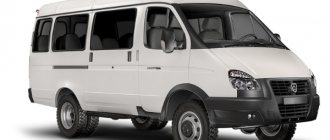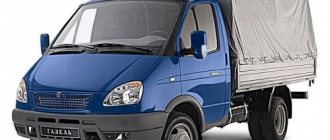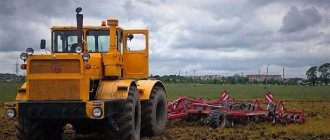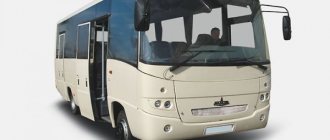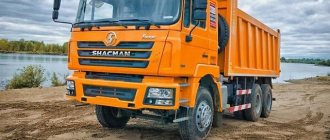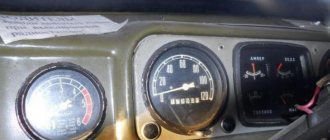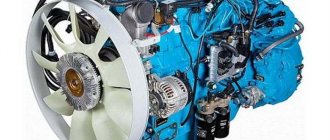Model history
Throughout the first decade of the 2000s, every year it became more and more obvious that the huge commercial success of Gazelle cars in the Russian and CIS markets would not last forever. Gazelle has plenty of competitors in the field of light-duty business vehicles, and they all have something to interest a potential buyer.
The price factor no longer always became the most important and determining factor when purchasing, especially since the car lending system has developed extraordinary over the years, and loans began to be issued to almost “everyone.” And buyers have become more picky, able to compare and contrast, and are ready to overpay for comfort and reliability in operation, and increased profitability. Therefore, “Gazelle” gradually lost its position, being forced out of the market by more expensive, but also more modern imported “classmates”.
A “response move” in this situation could only be the launch of mass production of a new car, corresponding in quality to modern “classmates” (such as Mercedes Sprinter, Peugeot Boxer, Volkswagen Crafter, Ford Transit, Fiat Ducato ", etc.) But at the same time having a more attractive price!
Meanwhile, the new family may not have reached the assembly line, which has happened more than once with other developments by domestic designers. The following course of action was considered: not to go into the business of creating your own model, which requires enormous capital investments and hassle, but simply assemble the previous generation Mercedes Sprinter at GAZ facilities.
However, even with the highest level of localization, the German light-duty vehicle turned out to be by no means cheap, and in no way falls into the rank of a “budget” car. Domestic consumers, for the most part, should be given a simple frame car (the Sprinter has a monocoque body), which can be overloaded regularly and without serious consequences, and all sorts of minor repairs can be carried out, as they say, “on the knee”, without taking a long break from workflow.
To prepare for the release of the new model, the Gorky Automobile Plant carried out a large-scale modernization of production. The total investment in the Gazelle Next project amounted to almost nine billion rubles.
To produce the new model of the all-metal GAZelle Next van, new automated welding and stamping complexes were created at the Gorky Automobile Plant sites, the painting production and assembly line were modernized.
The automated stamping line is equipped with the latest multifunctional six-axis robots of the latest generation and presses with imported stamping equipment specially made for the project. The line produces large parts, including side panels, bases, sliding and swing doors.
The new welding line allows automatic production of bodies of various modifications. Modern Fanuc robots with a lifting capacity of up to 700 kg are installed in the welding areas of the sidewalls, base, body and door assembly-welding. Each robot, independently changing equipment, is capable of performing operations such as transporting parts, welding, flanging, and applying adhesives and sealants. The welding line also includes new overhead push conveyor routes and automated components supply systems.
Following the basic flatbed version and the universal chassis, other “Gazelle Next” followed: in March 2014, serial production of a truck with a seven-seat double cabin and a bus with a frame-panel body in urban and intercity versions began; In April 2016, sales of all-metal Gazelle Next vans started.
The substantial investments began to pay off: new cars are selling well on the domestic market: more than fifteen thousand buyers choose them every year. The Gazelle Next assembly production for the needs of the local market was also organized in Turkey.
Predecessor and main features of the YaMZ-534 engine
Externally, GAZelle Next has radically changed in comparison with the previous Gazelle. In the front part, attention is drawn to the large radiator grille and the large, voluminous bumper with fog lights integrated into it. The plastic body kit is made of four different segments. Due to this, in case of minor accidents, the metal front part of the car will not be damaged, and it will not have to be replaced.
The headlights are the same; almond-shaped, or teardrop-shaped. Only they are located much higher, at the junction of the plastic wings, the sloping hood and the side of the bumper. By the way, the long-standing problem of wing corrosion has been solved radically and forever: now they are not metal, but plastic.
The side rear view mirrors have increased by about a third. They became divided into 2 parts, one of them is panoramic. The mirror mounts have become much stronger and more reliable. In addition, the base already has electrically heated mirrors. The more expensive configuration also includes electrical adjustment. Under the cab on both sides there are hidden drawers for tools and the factory hood seal. Windshield washer nozzles are now located on the windshield wipers.
Raising the hood, one cannot help but notice that the engine compartment has become more spacious, thanks to which GAZ specialists were able to space out the intercooler and the main radiator of the cooling system. This, together with the fact that the purge area of the radiator itself has almost doubled, significantly reduced the thermal load on the engine.
It is impossible not to note the abundance of foreign-made parts and components: ZF steering; front optics "Magneti Marelli"; anti-lock braking system manufactured by Bosch; "Mando" braking system; SKF gearbox bearings; Sachs clutch; wheel bearings "Schaeffler";
In motion, the “next Gazelle” has become quieter compared to the usual one, the smoothness of the ride on a broken road has noticeably increased, and the problem of suspension rigidity and noise in the car when driving in an unloaded state has been eliminated. Driving performance was improved by revising the aerodynamics and refining the cabin supports, improving the design of the rear suspension and springs (something that Gazelle owners have long pointed out).
The main innovation, which takes the Gazelle Next to a completely different level of comfort, is the new independent front suspension on double wishbones. Even the basic equipment is equipped with 9th generation four-channel ABS.
According to the manufacturer, another pressing problem of the Gazelles has been solved - the high susceptibility of the body to corrosion. It is claimed that the body of the Gazelle Next is of high quality. Only galvanized metal is used to make the running boards, hood, wheel arches, doors and side panels.
Especially for the production of the new family, an advanced hydroelastic stamping press “Quintus FlexForm” was launched in Nizhny Novgorod, which allows the use of a one-sided matrix when creating liquid pressure at a level of 100 MPa. Equipment is used to create body elements for Gazelle Next, making them of higher quality.
The YaMZ-534 Euro-4 engine is an in-line four-stroke diesel engine, with compression ignition, direct injection, liquid cooling, turbocharging and charge air cooling in an air-to-air heat exchanger. Each of the engine cylinders has four valves each.
Although the Yaroslavl Motor Company’s lineup already included the 4-cylinder YaMZ-204 engine, which was discontinued more than twenty years ago, this, as they say, was “a completely different story.” Because that engine was a heavy diesel engine. And the design did not even provide for its equipping with a turbocharging system. Therefore, the four-cylinder YaMZ-204 can be called the predecessor of the 534, but only with a stretch.
After all, the YaMZ-534 is a medium-sized in-line diesel engine, developed, as they say, “from scratch” by the design bureau of the Yaroslavl Motor Plant, together with the Austrian engineering bureau “AVLListGmbh”.
Distinctive features of YaMZ-534 are compliance with modern environmental standards Euro-4; the presence of an electronic control unit (ECU) and the use of a modern direct injection system using the CommonRail battery fuel system.
Achieving a high level of environmental standards was made possible largely thanks to the use of the EGR exhaust gas recirculation system. One of the advantages of this solution is simplification, and therefore reduction in cost, of placing the engine on the car.
“YaMZ-534” is a fundamentally new design, using the most current and advanced solutions, the rights to which belong to the GAZ Group (in recent years, this holding has included the Yaroslavl Motor Plant).
Lawn Next truck with YaMZ 53441-2 engine (150 hp)
For the serial production of diesel engines of the 530 family, a completely new plant was built and launched as part of YaMZ - Avtodizel OJSC. This new enterprise is located on the current outskirts of the city, as the locals say - “beyond the Volga”, about a twenty-minute drive from the old plant.
This is the most modern production of diesel engines not only in Russia, but throughout Eastern Europe.
This modern industrial site has almost a 90% level of production automation, and all production equipment on it is from the world's leading manufacturers. In addition to the new 530 series diesel engines, German engines for Mercedes Sprinter minibuses are also assembled here.
Among the suppliers of individual components and components of the new Yaroslavl 4-cylinder engine are such venerable manufacturing companies with a long-term and impeccable reputation as Bosch, ZF, FederalMogul, BorgWarner, MannHummel, Behr, Knorr/ Bremse" and others.
The casting of the block and cylinder head is carried out in Germany, at the FritzWinter enterprise.
However, the new Yaroslavl four-cylinder diesel engines do not consist entirely of imported components and components, as it might seem. For example, CommonRail fuel equipment is Russian-made, from the Yaroslavl Diesel Equipment Plant.
The electronic control unit and, what is especially characteristic, the software for it, were developed by St. Petersburg, and the production of the ECU itself was mastered at the Stary Oskol Automotive Electrical Equipment Plant.
The production of electronically controlled fuel injectors, providing increased spray pressure and multi-phase injection (three portions), has been established at the Altai Precision Products Plant in the city of Barnaul.
Currently, the price list of the Yaroslavl Motor Plant includes nine modifications of the YaMZ-534, in a power range from 136 to 190 horsepower. The YaMZ-534/CNG gas engine, which was the fruit of cooperation with a Canadian manufacturing company, stands out in particular.
Interior
Inside, the Next modification has become much more spacious - about 1/3 more than the Lawn 3307. When you are inside, you understand that it has become more comfortable, because of this you even doubt a little whether this is a domestic car?
The interior space is largely similar to elements of the Gazelle Next. It is convenient to keep an eye on the road; the driver is helped by a fairly high seating position and a massive windshield. There are also innovations that are non-standard for cars of the Gorky Automobile Plant, such as:
- Electric windows;
- Air conditioning;
- Cruise control;
- Heated seats.
And all this comes as standard. Volga passenger sedans cannot even dream of this, but the Russian truck has it all! In front of the driver is a 4-spoke multi-steering wheel, which looks quite modern, almost the same as on other foreign cars.
GAZ-Next has a standard audio system with a CD player that supports the MP3 format, and also provides for mounting a pair of music speakers. The gas (accelerator) pedal is electronically controlled, but time will tell whether this can be considered an advantage given the quality of domestic spare parts.
Inside it can comfortably accommodate 3 adults, although a double cabin can be ordered with a driver and 6 passengers. Everything is quite simple, but at the same time convenient. The designers of the Gorky Automobile Plant did a good job on a comfortable fit, good ventilation and noise insulation.
The Lawn Next cabin can accommodate 3 adults. They also increased the rigidity of the driver's compartment using Anvis mounts. The driver's seat has a large number of settings and a mechanical suspension, which minimizes driver fatigue even during a long trip.
The basic configuration also has armrests. The instrument panel looks intuitive and quite clear, there is a pleasant backlight. The center console has a free niche for installing third-party multimedia devices.
Review of YaMZ-534 modifications and scope of their application
In terms of their capabilities, YaMZ-534 engines are very versatile. These motors effectively perform the functions of power units on a variety of equipment weighing up to 12 tons, together with cargo; or on road trains weighing up to 21 tons. It is allowed to use these engines on vehicles with a number of wheels from 4 to 6, with two or four driving wheels.
Initially, YaMZ-534 diesel engines, all their modifications and configurations, were intended for installation on MAZ, Ural (new model), GAZ and GAZonNext (gas fuel) trucks, as well as small and medium capacity buses of the PAZ brand.
The key differences between the individual modifications lie, first of all, in the settings of the ECU - an electronic fuel supply system optimized for specific tasks.
A more detailed overview of the specific application of modifications to these motors is as follows:
- “YAMZ-5340” is a basic modification used as a power unit for trucks, dump trucks, chassis, tractors with the wheel arrangement “4x2”, “4x4”, “6x2”, “6x4”, with a gross weight of up to 12 tons, road trains on their basis up to 21 tons - Minsk Automobile. There are also three additional modifications: with preparation for installation of an air conditioning compressor (“YaMZ-5340/01”), with a fan (“YaMZ-5340/02”), with a fan prepared for installation of an air conditioner compressor (“YaMZ-5340/03”) .
- "YAMZ-53402" - designed for trucks "Ural-432065" and other vehicles of the "Ural" brand, including all-terrain vehicles with a 4x4 wheel arrangement, with a total weight of up to 13 tons, for road trains based on them up to 24 -x tons weighing. A separate special modification “YaMZ-53402-10” is used as part of the tracked snow and swamp-going vehicle “ZZGT”.
Truck "Ural-432065" with engine "YAMZ-53402" (190 hp)
- “YAMZ-5341” - this engine is used as a power unit for the following MAZ-branded equipment: medium-tonnage vehicles, on a vehicle chassis with a 4x2 wheel arrangement and a total weight of up to 6 tons, for road trains based on them up to 10 tons, and for buses.
- “YAMZ-5341/10” - this motor is used as a power unit for buses of the “PAZ-320412” family, with a gross weight of up to 11 tons. There is also a special modification “YaMZ-5341/11” for installing an air conditioning compressor.
- "YaMZ-5342" - used as a power unit for buses of the "PAZ-320402", "PAZ-4234", "PAZ-3237" models, with a gross weight of up to 11 tons.
- YaMZ-5344 is a modification for PAZ-32053 buses.
- YaMZ-5344-10 is a diesel engine option specifically for medium-tonnage trucks of the GAZ-3308 (Sadko) and GAZ-3309 family.
- YaMZ-53442 is a special modification designed for medium-tonnage off-road trucks of the GAZ-3308 family and their chassis.
- YaMZ-534/CNG is the newest and most promising modification, launched into production only at the end of 2015. Powered by gas. At first, it will be equipped with new versions of GAZ trucks, and in the near future – with a wide range of all kinds of equipment for various purposes.
In addition, since May 2014, the plant launched serial production of an accelerated modification - "YAMZ-53472-10", with a power of 215 horsepower at 2600 rpm, specially designed for the new army armored vehicles "GAZ-233036" (it aka "SMP-2 "Tiger").
The main options for the Gazelle Next car are a truck, an onboard cargo platform; universal chassis for installing settings and all kinds of special equipment; bus in city and intercity interior design; all metal van. The vehicle is available with a standard or extended wheelbase.
1. The flatbed version differs from the regular Gazelle by a reinforced frame and the use of stainless materials. The architecture of the platform has also been improved. If previously only three euro pallets could be placed in the body, now their number has increased to five, which immediately increases transportation productivity by forty percent! The load capacity of the frame chassis, however, has not changed, but voluminous loads, according to tradition, prevail over particularly heavy ones. Yes, and periodic overload of the Gazelle Next, like the previous Gazelle, will not frighten you. Modifications of the onboard Gazelle Next:
- With Cummins diesel: A21R22-30 – standard base; 3-seater cabin, A21R32-30 – extended wheelbase; 3-seater cabin, A22R22-30 – standard base; 7-seater cabin, A22R32-30 – extended wheelbase; 7-seater cabin.
- With UMZ gasoline engine: A21R23-20 – standard base; 3-seater cabin, A21R33-10 – extended wheelbase; 3-seater cabin, A22R23-10 – standard base; 7-seater cabin, NEXT A22R33-20 – extended wheelbase; 7-seater cabin.
- With UMZ gas engine: A21R25-20 – standard base; 3-seater cabin, A21R35-10 – extended wheelbase; 3-seater cabin, A22R35-20 – extended wheelbase; 7-seater cabin.
manufactured goods or isothermal van; europlatform; bread van; mobile auto shop; tow truck with broken platform; auto hydraulic lift; dump truck with three-way unloading; a vehicle with a crane-manipulator; milk tanker; ambulance; a vehicle for transporting people with disabilities; police duty vehicle; fire engine; "House on wheels".
Bread van on the Gazelle Next chassis.
3. The Gazelle Next passenger minibus is designed as a city minibus or as a commuter bus. Plus, this new product isn't just built around an all-metal van. Frame-panel technology was also used - using durable steel pipes, galvanized metal sidewalls and fiberglass panels.
Modifications of minibuses "Gazelle Next":
- Based on an all-metal van, 16 seats: A65R33-60 – with UMZ gasoline engine; A65R32-40 – with Cummins diesel engine; A65R35-60 – with UMZ gas engine;
- With frame-panel body, Cityline, 18-19 seats: A64R42-10 – city; A63R42-10 – commuter; A60R42-1010-56-721-70 – tourist (with Cummins diesel engine); A64R45-50 – urban; A63R45-50 – suburban (with UMZ gas engine).
Modifications of "Gazelle Next" in the "all-metal van" version:
- With UMZ gasoline engine: A31R23-20 – three-seater cabin, standard wheelbase; A32R23-20 – seven-seat cabin, standard wheelbase; A31R33-20 – three-seat cabin, extended wheelbase; A32R33-20 – seven-seat cabin, extended wheelbase.
- With Cummins diesel: A31R22-40 – three-seater cab, standard wheelbase; A32R22-40 – seven-seat cabin, standard wheelbase; A31R32-40 – three-seater cabin, extended wheelbase; A32R32-40 – seven-seat cabin, extended wheelbase.
fog lights; modern radio with USB connector and steering wheel controls; electric side mirrors; heated driver's seat. By paying extra, the buyer can get the top-end K2 package, which differs from K1 in the presence of a pre-heater, a heater and a battery with increased energy capacity.
Other methods of bleeding the fuel system of a diesel engine
So, above we looked at the main way to bleed a diesel fuel system. At the same time, many specialists and experienced car enthusiasts separately point out that in some cases such attempts to bleed the pump can have serious consequences for the power system.
Please note that the reason for this concern is that if there is mechanical damage, bleeding in this manner can cause irreparable damage. Let's look at other existing methods.
- First of all, the bolt on the fuel return line (the so-called “return”) is loosened. Next, you should carefully monitor how the fuel comes out. If air bubbles are visible, then this means that the system is airy.
If so, you can use a simple tire inflator or compressor. Next, the hose is removed from the fuel pump and the air pump hose is installed in its place. The basic idea is that pumping occurs, which allows the pressure in the system to increase. This pressure makes it possible to pump diesel fuel into the fuel pump.
We also recommend reading the article about why air leaks occur in the fuel system of a diesel engine. From this article you will learn about the main signs and causes of airing in the power system on diesel engines, as well as methods for diagnosing and repairing this problem.
- Another pumping method can be described as “household”, since it involves the use of a home vacuum cleaner. The main thing is that the device has sufficient power.
So, first the fuel filter is removed and its housing is dried. Then the individual elements are wiped, then reassembled. Next you will need to locate two fittings on the filter housing. One of the fittings is needed for draining diesel fuel, and the other is suitable for pumping.
Having prepared the vacuum cleaner, you also need a regular medical syringe and a hose 30-40 cm long. For these purposes, it is recommended to use a transparent type of hose. The syringe is inserted into the hose, and the other end of the hose is put on the bleeder fitting.
Next, the piston is pulled out of the syringe, and the vacuum cleaner tube is inserted into the syringe. The main thing is to achieve reliable fixation and a tight fit. Also, the joints can be sealed by putting on pieces of hoses of different diameters, winding electrical tape, etc.
Now you can unscrew the fitting a little, after which the vacuum cleaner turns on. After a few seconds, yellowish foam can be seen in the syringe. This is a mixture of diesel fuel and air. Further pumping comes down to ensuring that the syringe is filled with clean diesel fuel instead of foam.
Let's consider another solution that allows, in some cases, to quickly pump the diesel fuel system. To do this, it is enough to completely fill the fuel filter housing with diesel fuel, after which the engine starts. Next, you need to let the engine run at high speeds, as a result of which the power system is pumped.
Technical characteristics of the YaMZ-534 engine
All of these modifications of the new four-cylinder diesel engines are maximally unified among themselves and cover the power range from 136 to 215 horsepower. At the same time, the minimum specific fuel consumption is, according to the manufacturer, 145 g/l.h.h. And this number is a very good indicator by modern standards, meeting the most current fuel efficiency standards.
Thanks to the presence of the innovative CommonRail direct injection battery fuel system, equipped with an ECU - an electronic control unit, precise fuel supply calibration parameters are achieved for a number of diverse operating modes. This makes it possible to simultaneously ensure both a reduction in fuel consumption and an increase in engine efficiency.
Some technical indicators in specific terms:
- Working volume – 4430 cubic centimeters;
- Power - from 136 to 215 hp, depending on modification, at 2300-2600 rpm;
- Number and arrangement of cylinders – 4, “L”;
- Cylinder diameter/piston stroke, in millimeters – 105/128;
- Compression ratio – 17.5;
- Maximum torque, Nm (kg/s.m) – 735 (75);
- Rotation speed at maximum torque – 1300-1600 rpm;
- The height of the crankshaft axis is 300 mm;
- Environmental indicators – Euro-4 (EGR POC);
- Overall dimensions (Length/Width/Height), in millimeters: 972/712/836;
- Engine weight, unfuelled: 480 kg;
- Cylinder operating order: 1 – 3 – 4 – 2;
- Power system: CR direct injection.
To achieve the Euro-4 environmental level, an EGR (exhaust gas recirculation) system and a catalytic converter with a replaceable filter are used.
We can hope that the new YaMZ-534 engine will become another example of a reliable, unpretentious and durable solution for a power unit. After all, the Yaroslavl Motor Plant has been the largest player in the industry for more than half a century and has not betrayed itself. In the sense that its classic products - engines of the YaMZ-236, YaMZ-238 family have an impeccable reputation as engines that are extremely durable and reliable, a sort of “perpetual motion machine” among diesel engines.
Engine "YaMZ 534" in the assembly shop of the plant
The new power unit, YaMZ-534, according to the manufacturer, has a predicted service life before major overhaul from 700 thousand to 1 million km; with the need for maintenance every 30 thousand km. (or 1000 hours of work).
The rate of oil consumption due to waste is no more than 0.1% of diesel fuel consumption, which corresponds to the most advanced examples of such equipment from the world's leading manufacturers.
The manufacturer's warranty for power units of this series is two years, or 100 thousand kilometers.
YaMZ-534 motors are in high demand on the market: their production volumes amount to tens of thousands of units per year. In this case, the first maintenance is scheduled after 15 thousand km (or 500 hours), the second and subsequent engine maintenance – after 30 thousand km (or 1000 hours)
Description of YaMZ-530 systems... On the path to success
| YaMZ engines: 534, 536, 530 Overview and technical characteristics The following control sensors operate in the fuel supply system: speed, phase, fuel pressure, fuel temperature, charge air temperature, charge air pressure, coolant temperature, oil pressure. km hour Weight, kg Overall dimensions, mm l w h Purpose, consumer YaMZ-53411-10 -11 125 170 2300 664 67.1 1300-1600 193 142 600 480 886 717 940 PAZ buses weighing up to 11 tons, Vector 4, PAZ -320402, PAZ-4234 YaMZ-53421 -01, -02, -03 110 150 2300 585 59.6 1300-1600 195 143 600 480 890 717 961 PAZ buses weighing up to 11 tons, Vector 4, PAZ-32040 2, PAZ- 4234 YaMZ-53431 -01 100 136 2300 420 42.8 1200-2100 197 145 600 480 890 717 961 PAZ buses weighing up to 8 tons, PAZ-32053 YaMZ-53441-20 -21 110 15000- 2100 197 145 700 480 941 715 976 GAZ medium-duty trucks GAZon NEXT, chassis 4x2 YaMZ-5346 -01 125 17000-1600 194, 5 143 600 480 886 708 940 KAVZ city and suburban buses weighing up to 12, KAVZ-4235. |
| Maz 534 – Engine YaMZ-534 | Characteristics, oil, is it reliable? TeploEnergoRemont Emissions of harmful and polluting substances are reduced due to exhaust gas recirculation, EGR system, catalytic converter with a replaceable cartridge. High-pressure fuel pump 2 is a three-plunger block high-pressure pump with a gear drive and a gear fuel priming pump. |
- selective catalytic reduction (“SCR”) system, which consists of a dosing module and a tank for an aqueous solution of urea - AdBlue reagent - 32% solution of (NH2)2C0.
- selective catalytic converter (muffler-neutralizer).
Lubrication system of the YaMZ-536 engine • The YaMZ-530 engine is the first in diesel power plants.
Gazelle Next parameters, standard base
- length – 5.630 m;
- width – 2.068 m;
- height – 2.137 m;
- wheelbase - 3.145 m;
- turning radius – 5.6 m;
- ground clearance - 170 mm;
- front track - 1,750 m;
- rear track – 1,560 m;
- curb weight – 2,060 t;
- load capacity – 1,440 t;
- total weight – 3.5 t;
- maximum speed – 134 km/h.
- length – 6.709 m;
- width – 2.068 m;
- height – 2.137 m;
- wheelbase - 3.745 m;
- turning radius – 6.5 m;
- ground clearance - 170 mm;
- front track - 1,750 m;
- rear track – 1,560 m;
- curb weight – 2,230 t;
- load capacity – 1,270 t;
- total weight – 3.5 t;
- maximum speed – 132 km/h.
The loading height is 95 centimeters. internal dimensions of the cargo platform: length – 3090 mm (standard); 4168 mm (extended version) – with a 3-seater cabin; length – 2339 mm (standard); 3090 (long version). Overhang angle (with load): front – 22 degrees; rear - 16 degrees. The maximum volume overcome is 26 degrees.
Dimensions of the minibus in millimeters (length x width x height): 6080x2530x2720. Wheelbase - 3745 mm. Gross weight - 4252-4292 kg.
Operating experience and reviews from YaMZ-534 owners
The owners of Gazelle Next note that this is truly a completely new, modern, comfortable and productive car. It is cheaper than imported analogues and is less expensive to maintain. The basic package is rich in options. Fuel consumption, although slightly higher than stated by the manufacturer, is generally pleasing.
It starts well in the cold, down to minus 20 degrees. In hot weather, you can often see regular Gazelles with the hood slightly open, with a plastic bottle inserted into the crack. On the Gazelle Next, the possibility of overheating was eliminated by installing a much larger aluminum radiator. The owners could not help but note the new cargo platform of the GAZelle Next.
One of the minuses is the archaic gear shift knob, which sticks out lonely from the floor in the middle of a modern and comfortable interior. “Where is the joystick on the podium{q},” spoiled consumers ask. People also grumble about the unassuming “oak” plastic of the panels, the shapes of which are cast in places of poor quality, with burrs. Problems often arise with wiring and rear lighting devices: the contacts either come off on their own or close for no apparent reason.
But in general, all owners of GAZelle Next, especially those who switched from regular Gazelle, unanimously declare that the cars of the Gorky Automobile Plant have actually made a sharp leap forward, and not only in design and comfort, but also in quality of performance and assemblies. The cost, although it cannot be called cheap, is still more attractive than similar “Europeans” - for quite reasonable money you can get a reliable, practical and comfortable car. Where it will be pleasant to work and earn money.
Experience of owners of cars with YaMZ-534 engines, produced in 2011-2013 and already, so to speak, “smelling gunpowder”, i.e. have proven themselves under conditions of intensive use, indicating that the motor is good. More specifically: reliable; when necessary - high-torque, when necessary - playful and resourceful; works quietly; and, what is especially important in our time, economical (about 15-17 liters).
Each buyer of diesel equipment of this type has two options: YaMZ-534 or Chinese-made Cummins.
The Yaroslavl motor, judging by experience and reviews, is much better: more unpretentious, trouble-free, and, although not particularly cheap; Still, in terms of the price of spare parts and the engine itself, it will be preferable. And “YaMZ-534” cannot boast of an inexpensive price quite naturally: after all, a considerable part of the components and assemblies on it are from European manufacturers.
However, “jingoism” in the field of new technical developments is inappropriate in our modern era. And using technologies and ready-made units from world industry leaders is, perhaps, the right decision. Since using them turns out, as they say, “a completely different song.”
Cabin "Gazelle Next"
The doorway area of the Gazelle Next cabin is 23 percent larger than in a regular Gazelle. The interior has become taller and overall there is more space. The driver's seat "Isringhausen" is imported from Germany and provides lumbar support, as well as adjustment in all directions. It is possible to adjust the height of the seat belt fastening.
The plastic of the cabin panels is still inexpensive and rigid. However, it received a new shape and texture. The instrument panel includes 2 dials and an on-board computer display. The ergonomics of the interior are pleasing: there are many useful shelves and pockets, there are 2 cup holders and 2 bottle holders, there is a coat hook on the wall, and for an additional fee you can install a shelf for a radio station under the ceiling. Buttons and other control devices operate smoothly and look good.
An adjustable armrest has appeared between the seats, which does not interfere with changing gears at all. The left (door) armrest runs the entire width of the door; on the passenger door the armrest is noticeably shorter. By the way, GAZ specialists implemented this innovation “at the request of the workers,” who complained about the insufficient length of the cabin, which made it difficult to stretch out while lying at full height.
The Gazelle Next cabin is also distinguished by its safe design, due to the inclusion in the configuration of special power elements that have specified deformation points. In an accident, they take most of the impact. Seat belts received pretensioning devices.
In the double version, there is an additional swing door on the right side to facilitate the boarding and disembarking of passengers from the “gallery”. The basic package additionally includes a pre-heater, a heater, an increased power battery, a heated fine fuel filter and an additional 12V socket in the rear of the cabin.
Gear shift
To change gears silently, press the clutch pedal all the way down.
To avoid premature wear of the synchronizers, the lever should be moved smoothly, with a short delay in the neutral position, according to the diagram shown in the figure and on the gear shift lever handle. A fuse is provided in the gearbox to prevent accidental engagement of reverse gear R.
Reverse gear should be engaged after the vehicle has come to a complete stop.
Gears are engaged only from the neutral position N. In this case, if the instruments and the starter are turned on, the reverse lights come on in the rear lights.
ATTENTION!
Do not constantly keep your foot on the clutch pedal while the vehicle is moving. This may damage the clutch.
To avoid damaging the clutch, do not engage first gear at vehicle speeds above 15 km/h.
Price of the Gazelle Next car
The price for the onboard version of the Gazelle Next starts at 995,000 rubles (3-seater cabin, standard base, gasoline); diesel - from 1,155,000 rubles; gas – from 1,055,000 rubles.
The price of the all-metal Gazelle Next van starts at 1,160,000 rubles (3-seater cab, standard base, gasoline); diesel - from 1,300,000 rubles.
The Gazelle Next bus based on an all-metal van can be purchased at a price of 1,400,000 rubles (gasoline); from 1,540,000 rubles (diesel); from 1,440,000 rubles (gas).
The Gazelle Next Cityline bus costs from 1,590,000 rubles (diesel); from 1,520,000 rubles (gas).
Despite its recent presence on the market, Gazelle Next is already widespread in the vast majority of regions of Russia and is represented on the secondary car market. They ask for used cars from 650,000 rubles (flatbed, tilt).


